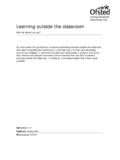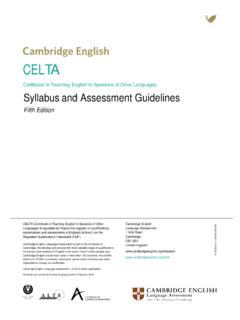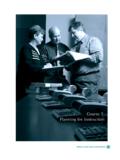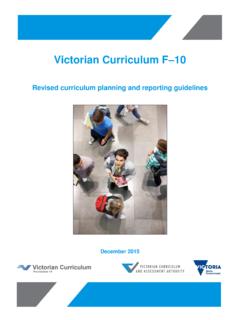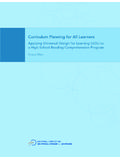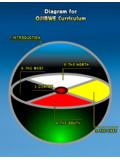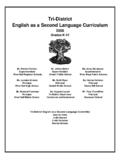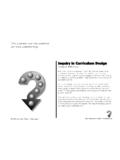Transcription of g Outside the Classroom Curriculum Planning - LOtC
1 Learning Outside the Classroom Curriculum Planning Crown copyright 2008 1 of 6 Step 1: What is happening now? As a Curriculum designer one of the first places to start might be with your current situation. This might involve carrying out an audit and building up an understanding of the complete range of the learning Outside the Classroom Curriculum provided, for example within and across year groups, key stages, subject areas, areas of learning, programmes and extended day provision. This may enable you to move on to the next stage which is about Planning provision. This approach should help you answer the two basic questions: What learning Outside the Classroom is currently taking place within my area of interest? Do these activities amount to a planned learning Outside the Classroom Curriculum ? Before starting to plan your new learning Outside the Classroom Curriculum you might like to think about the range of opportunities this offers: recognising that learning Outside the Classroom is an essential part of the learning process for all learners bringing learning to life through compelling learning experiences developing your Curriculum to improve motivation and engagement and raise standards offering a frequent range of learning Outside the Classroom experiences, both during and beyond the school day building on learners experiences as they learn and mature making use of a wide variety of expertise to enrich the learning experience providing opportunities for individual and group learning recognising the development needs of young people.
2 The answers to these questions will help you consider what provision to plan for. NB New approaches to the Curriculum are designed to enable schools to raise standards and help all learners meet the challenges of life in our fast-changing world. We need to find ways of bringing learning to life for all young people. Learning Outside the Classroom can achieve this and has similarities to what are referred to as compelling learning experiences . A compelling learning experience is a real and relevant context for learning through which young people recognise for themselves the importance of learning to their lives now and in the future. Step 2: Planning This step involves interpreting your aims and intended outcomes to create a whole Curriculum plan that has a clear focus on what is to be learned, how and where learning will occur, and how it will be Learning Outside the Classroom Curriculum Planning Crown copyright 2008 2 of 6 assessed.
3 The answers to the following questions will help you set the framework for future Curriculum Planning . 1. What do you want to achieve? 2. How do you provide continuity and progression? 3. Do all learners have sufficient opportunities for learning Outside the Classroom ? 4. How do you plan time? 5. How do you plan for teaching and learning? 6. What is appropriate? 7. When does it happen? 8. Where should activities take place? 1. What do you want to achieve? It is essential to be very clear about the aims and intended learning outcomes of experiences Outside the Classroom experiences. Here are some common features of learning Outside the Classroom that you may want to build into your plans: knowledge, skills and understanding related to subjects or learning Outside the Classroom activity Every Child Matters achieving the five outcomes underpins the Planning and delivery of extended services in and around schools social, citizenship or sustainability education values, attitudes, aesthetic awareness personal skills problem solving, self-reliance, independence, teamwork personal enjoyment and motivation adding value through building in ICT, literacy and numeracy.
4 2. How do you provide continuity and progression? These issues are key to the success of Curriculum design. Perhaps the most obvious place to begin is from the perspective of the individual learner. How can learning be presented to young people in such a way that it meets your aims and intended learning outcomes? How can it be organised so that it compels them to learn? In what ways can learning be made irresistible? Understanding what you want to achieve through learning Outside the Classroom activities provides the key to Planning for progression. For example, successive residentials should build on the achievements of previous ones rather than be a simple repetition. This will enable young people to experience fresh challenges. Approaches could include a commitment to the frequent use of school grounds and the local environment, a percentage of Curriculum time for learning Outside the Classroom in every subject or a Learning Outside the Classroom Curriculum Planning Crown copyright 2008 3 of 6 regular slot in the week for everyone, specific projects, a visit to a heritage or arts venue, a town-based project, a day at an education centre, a residential trip, or a trip abroad.
5 3. Do all learners have sufficient opportunities for learning Outside the Classroom ? Are opportunities varied to suit learning needs? (age, Key Stage, SEN) Does your Planning build on prior learning Outside the Classroom to provide challenge within and across phases and Key Stages? Find out whether your school is using the TDA School Improvement Planning Framework. 4. How do you plan time? Issues arising from inflexibility in Curriculum design are often cited as barriers to learning Outside the Classroom taking place. A range of strategies have been used in many schools to provide solutions, instead of the 45-minute to one-hour lesson as the basic building block of the timetable. Simple changes in the way in which time is chunked can strongly affect learners experiences of schooling and facilitate learning Outside the Classroom . Different approaches are being designed that give the learner a varied experience of the school day, week, term and year.
6 Examples include: Lessons lasting for a half-day or a whole day Short learning Outside the Classroom activities built into normal lessons Concentrated blocks of time at the start and end of a Curriculum theme so that subjects pull together related learning Study weeks within a school calendar where the normal cycle is put aside for more intensive or varied activities In-built longer sessions for certain subjects or areas to overcome the single lesson barrier Pairing subjects together to create longer blocks of time where two teams of teachers can programme learning Outside the Classroom jointly Creating a new Learning Outside the Classroom (subject) slot in the timetable with at least one longer session per cycle for either a project-based or personal learning and thinking skills led approach Moving from two to one year courses at Key Stage 4 creates longer blocks of time as fewer subjects are programmed for any given week.
7 This facilitates collaborative arrangements with other schools, institutions at 14 19 and providers of learning Outside the Classroom . All of these make it easier, especially for secondary schools, to arrange learning Outside the Classroom without requiring complex trade-offs with other subject areas or producing fragmented teaching groups where some learners are absent due to work at another location. Learning Outside the Classroom Curriculum Planning Crown copyright 2008 4 of 6 5. How do you plan for teaching and learning? Important for all experiences but essential when working in partnership with the wider workforce and with learning Outside the Classroom providers. More detailed guidance is provided in the next unit on The Learning Experience but below are some handy hints for designing the whole learning Outside the Classroom Curriculum : Plan to capture opportunities for follow-up (data, photos, samples etc) Design your Curriculum to make effective use of adults others than teachers/leaders Create effective partnerships between teachers, schools and learning Outside the Classroom providers Ensure when Planning with any partners providing external support, that there are clear roles for those leading activities Include assessment opportunities in designing your Curriculum See the SSAT link for publications on Curriculum design from NCSL: You will need to register with the SSAT website in order to access their publications, resources and other information.
8 See the direct link to NCSL Curriculum leadership resources: 6. What is appropriate? To ensure that learning Outside the Classroom is truly embedded in your Curriculum it should be built into Planning , so that you systematically develop it for the young people in your school or other setting. You will need to decide which way of delivering learning Outside the Classroom best suits your needs. Consideration will need to be given to frequency and length of time. There are many opportunities: play investigation exploration journeying fieldwork adventure expeditions and of course residentials. 7. When does it happen? Learning Outside the Classroom should be a part of planned teaching and learning time. However, there are further opportunities during the extended day, break times, during holidays and in youth activities Outside formal learning hours. Try to plan a range of learning Outside the Classroom activities throughout the year.
9 Many can take place inside museums, heritage sites, places of worship and so on. Outside activities can be offered all year round; it has been said: there s no such thing as bad weather just bad clothing! 8. Where should activities take place? The choice of where to experience learning Outside the Classroom is endless. The place you decide on can influence how effective the learning is. It is important that the place you choose for learning suits what you have planned to achieve. The frequency is likely to mean that many activities or experiences Learning Outside the Classroom Curriculum Planning Crown copyright 2008 5 of 6 take place close to your usual place of learning, for example school grounds or within walking distance. However, you will also need to plan for a range of activities further away and for residential experiences. Learning opportunities Outside the Classroom offer the richest resources available and are often free!
10 Before developing your own plans it is important to remember that learning Outside the Classroom is seated firmly in learning and that most learners should not have to wait for very long during a week before being engaged in first-hand, active learning experiences. Involving staff Any school considering expanding its learning Outside the Classroom provision should begin by consulting staff. Such a consultation should have four aims. 1. To make the case for learning Outside the Classroom to all staff 2. To encourage all staff to plan and participate 3. To identify staff teachers and support staff willing to lead learning Outside the Classroom activities 4. To identify any professional development needs arising from learning Outside the Classroom implementation Involving young people Any learning Outside the Classroom programme will need to engage the interest of the children and young people who take part.


